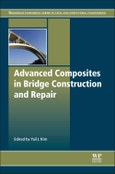Advanced composite materials for bridge structures are recognized as a promising alternative to conventional construction materials such as steel.
After an introductory overview and an assessment of the characteristics of bonds between composites and quasi-brittle structures, Advanced Composites in Bridge Construction and Repair reviews the use of advanced composites in the design and construction of bridges, including damage identification and the use of large rupture strain fiber-reinforced polymer (FRP) composites. The second part of the book presents key applications of FRP composites in bridge construction and repair, including the use of all-composite superstructures for accelerated bridge construction, engineered cementitious composites for bridge decks, carbon fiber-reinforced polymer composites for cable-stayed bridges and for repair of deteriorated bridge substructures, and finally the use of FRP composites in the sustainable replacement of ageing bridge superstructures.
Advanced Composites in Bridge Construction and Repair is a technical guide for engineering professionals requiring an understanding of the use of composite materials in bridge construction.
Table of Contents
- Contributor contact details
- Woodhead Publishing Series in Civil and Structural Engineering
- Preface
- Part I: General issues
- 1. Using fiber-reinforced polymer (FRP) composites in bridge construction and monitoring their performance: an overview
- Abstract:
- 1.1 Introduction
- 1.2 Fiber-reinforced polymer (FRP) composites for bridge construction
- 1.3 Monitoring problems in bridges using FRP composites
- 1.4 Common nondestructive evaluation/testing (NDE/NDT) methods for bridges using FRP composites
- 1.5 Case study: monitoring a bridge with an FRP composite stay-in-place (SIP) formwork and an FRP composite reinforced concrete deck
- 1.6 Future trends
- 1.7 Sources of further information and advice
- 1.8 References
- 2. Prestressed fiber-reinforced polymer (FRP) composites for concrete structures in flexure: fundamentals to applications
- Abstract:
- 2.1 Introduction
- 2.2 Types and characteristics of fiber-reinforced polymer (FRP) composites
- 2.3 Using FRP composites in structures: design and applications
- 2.4 Internally bonded FRP tendons
- 2.5 Internally unbonded FRP tendons
- 2.6 Externally unbonded FRP tendons
- 2.7 Externally bonded post-tensioned FRP laminate
- 2.8 Near-surface-mounted post-tensioned FRP bars
- 2.9 Bond characteristics and deformability
- 2.10 Conclusions and future trends
- 2.11 Acknowledgment
- 2.12 References
- 3. Analyzing bond characteristics between composites and quasi-brittle substrates in the repair of bridges and other concrete structures
- Abstract:
- 3.1 Introduction
- 3.2 Experimental investigation of debonding
- 3.3 Fracture mechanics approach to the analysis of debonding
- 3.4 Numerical analysis of the fiber-reinforced polymer (FRP)-concrete interface
- 3.5 Design aspects related to debonding
- 3.6 Future trends
- 3.7 Acknowledgments
- 3.8 References
- 4. Identifying damage in honeycomb fiber-reinforced polymer (FRP) composite sandwich bridge decks
- Abstract:
- 4.1 Introduction
- 4.2 The damage severity correction factor (DSCF) method for damage identification: theory
- 4.3 DSCF-based damage identification method: key steps
- 4.4 Experimental verification of the DSCF-based damage identification method
- 4.5 Implementing the DSCF-based damage identification method with the experimental data
- 4.6 Using numerical modal analysis to identify damage
- 4.7 Damage identification using numerical data
- 4.8 Conclusions
- 4.9 Acknowledgments
- 4.10 References
- 5. Large rupture strain (LRS) fibre-reinforced polymer (FRP) composites for seismic retrofit of reinforced concrete (RC) piers
- Abstract:
- 5.1 Introduction
- 5.2 Properties of large rupture strain (LRS) fibre-reinforced polymer (FRP) composites
- 5.3 LRS FRP-confined concrete under monotonie compressive loading
- 5.4 LRS FRP-confined concrete under cyclic compressive loading
- 5.5 Seismic retrofit of reinforced concrete (RC) piers using LRS FRP composites
- 5.6 Acknowledgements
- 5.7 References
- 1. Using fiber-reinforced polymer (FRP) composites in bridge construction and monitoring their performance: an overview
- Part II: Applications
- 6. All-composite superstructures for accelerated bridge construction
- Abstract:
- 6.1 Introduction
- 6.2 Structural analysis and design
- 6.3 Manufacture and installation
- 6.4 In-service structural performance evaluation
- 6.5 Construction time and costs
- 6.6 Conclusions
- 6.7 Acknowledgment
- 6.8 References
- 7. Engineered cementitious composites for bridge decks
- Abstract:
- 7.1 Introduction
- 7.2 Engineered cementitious composites (ECCs) design theory
- 7.3 ECC mechanical properties and durability
- 7.4 ECC application in bridges
- 7.5 Conclusions
- 7.6 References
- 8. The use of carbon fiber-reinforced polymer (CFRP) composites for cable-stayed bridges
- Abstract:
- 8.1 Introduction
- 8.2 Design of carbon fiber-reinforced polymer (CFRP) bridge decks
- 8.3 Design of CFRP stay cables
- 8.4 Design of CFRP-steel hybrid stay cables
- 8.5 Case study: 1400 m cable-stayed bridges
- 8.6 Conclusions and future trends
- 8.7 Acknowledgments
- 8.8 References
- 9. Repair of deteriorated bridge substructures using carbon fiber-reinforced polymer (CFRP) composites
- Abstract:
- 9.1 Introduction
- 9.2 Investigating deterioration of concrete in bridges
- 9.3 Analysis of concrete deterioration in bridge substructures
- 9.4 Repair of bridges using carbon fiber-reinforced polymer (CFRP) composites
- 9.5 Review of CFRP repair of bridge substructure
- 9.6 Site testing of CFRP repair and laboratory testing of materials
- 9.7 Dealing with defects in CFRP repairs
- 9.8 Conclusions
- 9.9 References
- 10. Sustainable replacement of aging bridge superstructures using fiber-reinforced polymer (FRP) composites
- Abstract:
- 10.1 Introduction
- 10.2 Fiber-reinforced polymer (FRP) applications in bridge structures
- 10.3 Hybrid fiber-reinforced polymer (FRP)-concrete bridge superstructures
- 10.4 Conclusion
- 10.5 References
- 6. All-composite superstructures for accelerated bridge construction
- Index
Authors
Jimmy Kim Department of Civil Engineering, University of Colorado, Denver, USA..Dr Yail Jimmy Kim is an Associate Professor in the Department of Civil Engineering at University of Colorado Denver, USA. Dr. Kim is the Chair of
American Concrete Institute Committees 345 (Concrete Bridge Construction, Maintenance, and Repair) and 440I (FRP-prestressed Concrete). His current
research encompasses structural rehabilitation using advanced composite materials, performance evaluation of constructed facilities, bridge engineering,
concrete structures, intelligent structural systems, and science-based structural engineering, including condensed matter and statistical physics.








